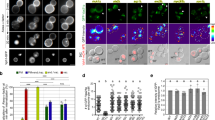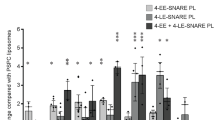Abstract
Although cAMP is well known to regulate exocytosis in many secretory cells, its direct target in the exocytotic machinery is not known. Here we show that cAMP-GEFII, a cAMP sensor, binds to Rim (Rab3-interacting molecule, Rab3 being a small G protein) and to a new isoform, Rim2, both of which are putative regulators of fusion of vesicles to the plasma membrane. We also show that cAMP-GEFII, through its interaction with Rim2, mediates cAMP-induced, Ca2+-dependent secretion that is not blocked by an inhibitor of cAMP-dependent protein kinase (PKA). Accordingly, cAMP-GEFII is a direct target of cAMP in regulated exocytosis and is responsible for cAMP-dependent, PKA-independent exocytosis.
This is a preview of subscription content, access via your institution
Access options
Subscribe to this journal
Receive 12 print issues and online access
$209.00 per year
only $17.42 per issue
Buy this article
- Purchase on Springer Link
- Instant access to full article PDF
Prices may be subject to local taxes which are calculated during checkout







Similar content being viewed by others
References
Rothman, J. E. Mechanisms of intracellular protein transport. Nature 372, 55–63 (1994).
Südhof, T. C. The synaptic vesicle cycle: a cascade of protein–protein interactions. Nature 375, 645–653 (1995).
Augustine, G. J. et al. Exocytosis: proteins and perturbations. Annu. Rev. Pharmacol. Toxicol. 36, 659–701 (1996).
Calakos, N. & Scheller, R. H. Synaptic vesicle biogenesis, docking and fusion: a molecular description. Physiol. Rev. 76, 1–29 (1996).
Bliss, T. V. & Collingridge, G. L. A synaptic model of memory: long-term potentiation in the hippocampus. Nature 361, 31–39 (1993).
Larkman, A. U. & Jack, J. J. Synaptic plasticity: hippocampal LTP. Curr. Opin. Neurobiol. 5, 324–334 (1995).
Nicoll, R. A. & Malenka, R. C. Contrasting properties of two forms of long term potentiation in the hippocampus. Nature 377, 115–118 (1995).
Weisskopf, M. G., Castillo, P. E., Zalutsky, R. A. & Nicoll, R. A. Mediation of hippocampal mossy fiber long-term potentiation by cyclic AMP. Science 265, 1878–1882 (1994).
Salin, P. A., Malenka, R. C. & Nicoll, R. A. Cyclic AMP mediates a presynaptic form of LTP at cerebellar parallel fiber synapses. Neuron 16, 797–803 (1996).
Chen, C. & Regehr, W. G. The mechanism of cAMP-mediated enhancement at a cerebellar synapse. J. Neurosci. 17, 8687–8694 (1997).
Kuba, K. & Kumamoto, E. Long-term potentiation of transmitter release induced by adrenaline in bull-frog sympathetic ganglia. J. Physiol. 374, 515–530 (1986).
Briggs, C. A. & McAfee, D. A. Long-term potentiation at nicotinic synapses in the rat superior cervical ganglion. J. Physiol. 404, 129–144 (1988).
Scott, T. R. & Bennett, M. R. The effect of ions and second messengers on long-term potentiation of chemical transmission in avian ciliary ganglia. Br. J. Pharmacol. 110, 461–469 (1993).
Dixon, D. & Atwood, H. L. Adenylate cyclase system is essential for long-term facilitation at the crayfish neuromuscular junction. J. Neurosci. 9, 4246–4252 (1989).
Prentki, M. & Matschinsky, F. M. Ca2+, cAMP, and phospholipid-derived messengers in coupling mechanisms of insulin secretion. Physiol. Rev. 67, 1185–1248 (1987).
Jones, P. M. & Persaud, S. J. Protein kinase, protein phosphorylation, and regulation of insulin secretion from pancreatic β-cells. Endocr. Rev. 19, 429–461 (1998).
Macrae, M. B., Davidson, J. S., Millar, R. P. & van der Merwe, P. A. Cyclic AMP stimulates luteinizing-hormone (lutropin) exocytosis in permeabilized sheep anterior-pituitary cells. Synergism with protein kinase C and calcium. Biochem. J. 271, 635–639 (1990).
Sikdar, S. K., Zorec, R. & Mason, W. T. cAMP directly facilitates Ca-induced exocytosis in bovine lactotrophs. FEBS Lett. 273, 150–154 (1990).
Vajanaphanich, M. et al. Cross-talk between calcium and cAMP-dependent intracellular signaling pathways. Implications for synergistic secretion in T84 colonic epithelial cells and rat pancreatic acinar cells. J. Clin. Invest. 96, 386–393 (1995).
Fujita-Yoshigaki, J. Divergence and convergence in regulated exocytosis: the characteristics of cAMP-dependent enzyme secretion of parotid salivary acinar cells. Cell Signal 10, 371–375 (1998).
Yoshimura, K., Hiramatsu, Y. & Murakami, M. Cyclic AMP potentiates substance P-induced amylase secretion by augmenting the effect of calcium in the rat parotid acinar cells. Biochim. Biophys. Acta 1402, 171–187 (1998).
Lonart, G., Janz, R., Johnson, K. M. & Südhof, T. C. Mechanism of action of rab3A in mossy fiber LTP. Neuron 21, 1141–1150 (1998).
Renström, E., Eliasson, L. & Rorsman, P. Protein kinase A-dependent and -independent stimulation of exocytosis by cAMP in mouse pancreatic β-cells. J. Physiol. 502, 105–118 (1997).
Kawasaki, H. et al. A family of cAMP-binding proteins that directly activate Rap1. Science 282, 2275–2279 (1998).
Wang, Y., Okamoto, M., Schmitz, F., Hofmann, K. & Südhof, T. C. Rim is a putative Rab3 effector in regulating synaptic-vesicle fusion. Nature 388, 593–598 (1997).
Ashcroft, F. M. Adenosine 5′-triphosphate-sensitive potassium channels. Annu. Rev. Neurosci. 11, 97–118 (1988).
Seino, S. ATP-sensitive potassium channels: a model of heteromultimeric potassium channel/receptor assemblies. Annu. Rev. Physiol. 61, 337–362 (1999).
de Rooij, J. et al. Epac is a Rap1 guanine-nucleotide-exchange factor directly activated by cyclic AMP. Nature 396, 474–477 (1998).
Su, Y. et al. Regulatory subunit of protein kinase A: structure of deletion mutant with cAMP binding domains. Science 269, 807–813 (1995).
Grootjans J. J. et al. Syntenin, a PDZ protein that binds syndecan cytoplasmic domains. Proc. Natl Acad. Sci. USA 94, 13683–13688 (1997).
Steinberg, R. A., Russell, J. L., Murphy, C. S. & Yphantis, D. A. Activation of type I cyclic AMP-dependent protein kinases with defective cyclic AMP-binding sites. J. Biol. Chem. 262, 2664–2671 (1987).
Burgoyne, R. D. Control of exocytosis in adrenal chromaffin cells. Biochem. Biophys. Acta 1071, 174–202 (1991).
Hawkins, R. D., Kandel, E. R. & Siegelbaum, S. A. Learning to modulate transmitter release: themes and variations in synaptic plasticity. Annu. Rev. Neurosci. 16, 625–665 (1993).
Ämmälä, C., Ashcroft, F. M. & Rorsman, P. Calcium-independent potentiation of insulin release by cyclic AMP in single β-cells. Nature 363, 356–358 (1993).
Goda, Y. & Stevens, C. F. Synaptic plasticity: the basis of particular types of learning. Curr. Biol. 6, 375–378 (1996).
Castillo, P. E. et al. Rab3A is essential for mossy fibre long-term potentiation in the hippocampus. Nature 388, 590–593 (1997).
Shirataki, H. et al. Rabphilin-3A, a putative target protein for smg p25A/rab3A p25 small GTP-binding protein related to synaptotagmin. Mol. Cell Biol. 13, 2061–2068 (1993).
Li, C. et al. Synaptic target of rabphilin-3A, a synaptic vesicle Ca2+/phospholipid-binding protein, depends on rab3A/3C. Neuron 13, 885–898 (1994).
Aguilar-Bryan, L. & Bryan, J. Molecular biology of adenosine triphosphate-sensitive potassium channels. Endocr. Rev. 20, 101–135 (1999).
Eliasson, L. et al. PKC-dependent stimulation of exocytosis by sulfonylureas in pancreatic β-cells. Science 271, 813–815 (1996).
Kotake, K. et al. Noc2, a putative zinc finger protein involved in exocytosis in endocrine cells. J. Biol. Chem. 272, 29407–29410 (1997).
Inagaki, N. et al. Cloning and functional characterization of a third pituitary adenylate cyclase-activating polypeptide receptor subtype expressed in insulin-secreting cells. Proc. Natl Acad. Sci. USA 91, 2679–2683 (1994).
Tanaka, J. et al. Cellular distribution of the P2X4 ATP receptor mRNA in the brain and non-neuronal organs of rats. Arch. Histol. Cytol. 59, 485–490 (1996).
Acknowledgements
We thank T. Sasaki for helpful advice and K. Yamaguchi for technical assistance. We also thank M. Takahashi for critical reading of the manuscript. This work was supported by a Grant-in-Aid for Creative Basic Research (10NP0201) from the Ministry of Education, Science, Sports and Culture; by Scientific Research Grants from the Ministry of Health and Welfare, Japan; by the Uehara Memorial Foundation; by a grant from Novo Nordisk Pharma Ltd.; by a grant for studies on the pathophysiology and complications of diabetes from Tsumura Pharma Ltd.; and by the Yamanouchi Foundation for Research on Metabolic Disorders. T.S. is supported by Research Fellowships of the Japan Society for the Promotion of Science for Young Scientists.
Author information
Authors and Affiliations
Corresponding author
Rights and permissions
About this article
Cite this article
Ozaki, N., Shibasaki, T., Kashima, Y. et al. cAMP-GEFII is a direct target of cAMP in regulated exocytosis. Nat Cell Biol 2, 805–811 (2000). https://doi.org/10.1038/35041046
Received:
Revised:
Accepted:
Published:
Issue Date:
DOI: https://doi.org/10.1038/35041046
This article is cited by
-
Aberrant methylation in neurofunctional gene serves as a hallmark of tumorigenesis and progression in colorectal cancer
BMC Cancer (2023)
-
EPAC2 acts as a negative regulator in Matrigel-driven tubulogenesis of human microvascular endothelial cells
Scientific Reports (2021)
-
Astrocyte Specific Remodeling of Plasmalemmal Cholesterol Composition by Ketamine Indicates a New Mechanism of Antidepressant Action
Scientific Reports (2019)
-
Optical approaches for single-cell and subcellular analysis of GPCR–G protein signaling
Analytical and Bioanalytical Chemistry (2019)
-
Y1 receptor deficiency in β-cells leads to increased adiposity and impaired glucose metabolism
Scientific Reports (2018)



